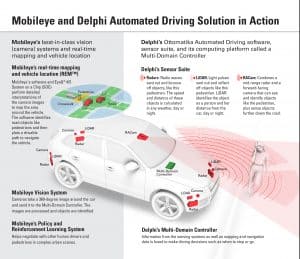 One of the nominees for the Tech CARS Awards will be on display at CES in January at the Las Vegas Convention Center. The Delphi and Mobileye system called CSLP that fuses camera and sensor data to get more accurate positioning in areas where GPS signals may be obstructed. VOTE for Tech CARS.
One of the nominees for the Tech CARS Awards will be on display at CES in January at the Las Vegas Convention Center. The Delphi and Mobileye system called CSLP that fuses camera and sensor data to get more accurate positioning in areas where GPS signals may be obstructed. VOTE for Tech CARS.
Automotive GPS is currently limited to ~1.5m resolution. CSLP provides a 10 cm resolution making the largest error 10cm where CSLP is able to place the center of a vehicle in a roadway lane while piloted autonomously.
The 2019 CSLP system offers localization and mapping capabilities that ensures the vehicle knows its location within 10 cm without GPS connectivity. It detects free space to help the car navigate complex lane splits or areas lacking lane markings. It is designed with 360-degree pedestrian sensing. 3D vehicle detection detects vehicles at any angle and can detect partial cars by identifying vehicles by overall shape and detect by wheel movement if a car is stationary or parked; critical for urban situations with unusually angled intersections. It alsoEnables lateral turning vehicle detection critical for intersections.
CSLP has ath and motion planning: Allows the car to behave more human-like in its driving behavior and determine the best path forward.
Both companies continue to develop next generation of sensor fusion technology as well as the next generation human-like “driving policy.” This module combines Ottomatika’s driving behavior modeling with Mobileye’s deep reinforcement learning in order to yield driving capabilities necessary for negotiating with other human drivers and pedestrians in complex urban scenes.
Delphi is also showing other systems and technology.
- 48-volt, mild hybrid solutions – for gasoline and diesel engines — to help OEMs meet future stringent emission standards affordably without sacrificing power and performance by integrating electrification with traditional powertrains.
- An improved Multi-layer display (MLD) to provide the flexibility to optimize a 3D viewing experience on both the Center Information Display (CID) and cluster.
- First-to-market V2V (vehicle-to-vehicle) technology that enables cars to talk to each other. This system will launch on the 2017 Cadillac CTS and feature a variety of warnings to the driver to augment existing active safety technologies. New this year, V2I (vehicle-to-infrastructure) applications will demonstrate how cars communicate with the infrastructure around them including traffic lights and road signs.
- A single powerful computing platform integrates multiple displays and consolidates domains, including infotainment, cluster and functional safety, to deliver a premium user experience with rich, smooth graphics.
- A centralized domain controller with satellite ADAS architecture enabling sensors that are up to 70 percent smaller for greater styling and packaging flexibility.
- Vehicle architectures with the bandwidth for OEMs to replace and upgrade systems ahead of consumer offerings with Over-the-Air (OTA) updates.